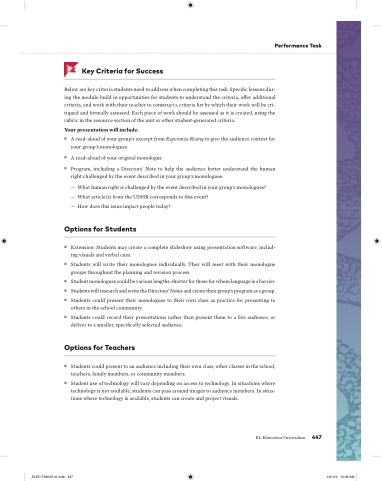Page 457 - EL Grade 5 Teacher Supporting Materials - Module 1
P. 457
Performance Task
Key Criteria for Success
Below are key criteria students need to address when completing this task. Speci c lessons dur- ing the module build in opportunities for students to understand the criteria, o er additional criteria, and work with their teacher to construct a criteria list by which their work will be cri- tiqued and formally assessed. Each piece of work should be assessed as it is created, using the rubric in the resource section of the unit or other student-generated criteria.
Your presentation will include:
■ A read-aloud of your group’s excerpt from Esperanza Rising to give the audience context for your group’s monologues
■ A read-aloud of your original monologue
■ Program, including a Directors’ Note to help the audience better understand the human
right challenged by the event described in your group’s monologues:
— What human right is challenged by the event described in your group’s monologues? — What article(s) from the UDHR corresponds to this event?
— How does this issue impact people today?
Options for Students
■ Extension: Students may create a complete slideshow using presentation software, includ- ing visuals and verbal cues.
■ Students will write their monologues individually. They will meet with their monologue groups throughout the planning and revision process.
■ Student monologues could be various lengths, shorter for those for whom language is a barrier.
■ Students will research and write the Directors’ Notes and create their group’s program as a group.
■ Students could present their monologues to their own class as practice for presenting to others in the school community.
■ Students could record their presentations rather than present them to a live audience, or deliver to a smaller, speci cally selected audience.
Options for Teachers
■ Students could present to an audience including their own class, other classes in the school, teachers, family members, or community members.
■ Student use of technology will vary depending on access to technology. In situations where technology is not available, students can pass around images to audience members. In situa- tions where technology is available, students can create and project visuals.
EL Education Curriculum 447
_ELED.TSM.05.01.indb 447
1/21/19 10:38 AM


